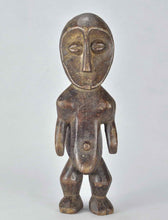MC1869 Statue LEGA Nene Kisi Cult of Bwami Figure Congo DRC
Regular price
€995.00
Sale
LEGA Statuette
Nene Kisi
Beautiful statue representing a Nene Kisi (one who owns the land)
The anthropomorphic statuettes used in the Bwami cult are generically called Iginga
The statue is inseparable from the aphorism associated with it.
The Bwami is a hierarchical association by ranks which organizes the social structure and ensures the stability of the Lega community.
Each level passage gives rise to initiation rites where one speaks, sings, dances, mimes and exposes. A multitude of aphorisms are used during the stories and songs
" The aim is to formulate and interpret in multiple symbolic ways the principles, moral and philosophical values and rules of the bwami, to each and to instill them, and to grant the initiates the paraphernalia relevant to their level of rank as well as their symbolic references, and to transmit the power, prestige and privileges that result from it " (Biebuyk, Sculptures don't speak 2010)
--------------------------
- Lega Jewels from the Benoît Rousseau Collection. Viviane Baeke, MRAC and Benoît Rousseau. 2013. BRUNEAF.
- The Lega and their art. In the footsteps of a dreamer lost in Congoland Emile-Alexandre Georges. 2005. Royal Museum for Central Africa.
- Bela Hein, great initiate of Lega ivories, Bernard de Grunne, 2001
- Treasures of Africa, Tervuren Museum, collective work, MRAC, 1995
(Notes by Daniel P. Biebuyck)
Nene Kisi League Figure
Sculpture of a Nene Kisi (The land owner)
Scarifications on the nose might seem a bit confusing for a Lega item
It is rare, but it does exist (see for example EA Georges p193, 1
The figures used in the cult of the Bwami are generically called Iginga
Collective, sacred properties, they are kept in secret, generally in closed wicker baskets. Their use is reserved at passages to the upper (Yananio) and supreme (Kindi) levels
The figure is inseparable from the aphorism associated with it
The Bwami is a hierarchical association by ranks which organizes the social structure and ensures the stability of the Lega community
Each change of level is accompanied with initiation rites where people talk, sing, dance, mime and exhibit. A multitude of aphorisms are used in stories and songs
The aim is to formulate and to interpret in multiple symbolic ways principles, moral and philosophical values and rules of bwami, to each and inculcate them, and to bestow upon the initiates the paraphernalia relevant to their grade level together with their symbolic references, and to convey the resulting power, prestige and privileges. (Biebuyk, Sculptures don’t speak 2010)
The Lega are a Bantu forest people of Central Africa, established in the east of the Democratic Republic of Congo (DRC), in the provinces of South Kivu and Maniema.
Features:
Please have a look on the pictures.











